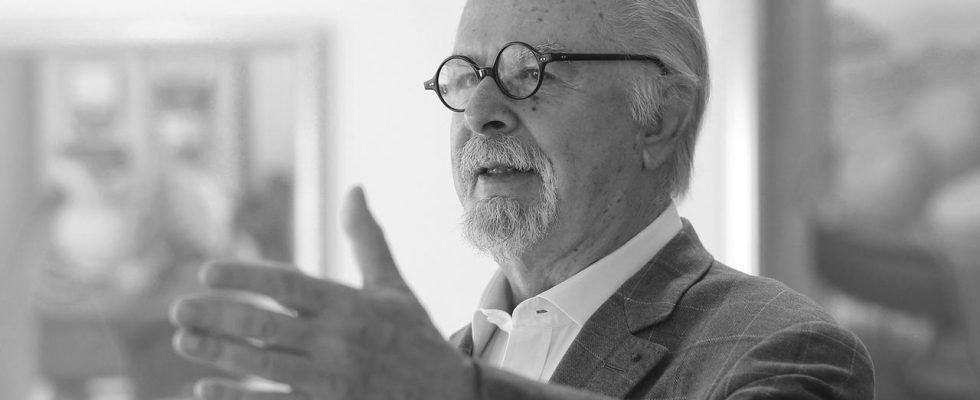People, animals or fruits: with the artist Botero everything was round, soft, voluminous. This unmistakable style made him famous. He always remained connected to his home country of Colombia – he has now died at the age of 91.
“I come to the studio around 10 a.m. and then work all day. I only briefly interrupt my work to go to a restaurant at lunchtime,” Fernando Botero once explained in an interview. At night he reads, watches a little TV and is in bed by 11 p.m. “That’s my rhythm. Even Saturdays and Sundays. Every day. And to this day I haven’t found anything that gives me more pleasure and joy than painting.”
Botero loved his work – until the end. His hometown of Medellín once tore down an entire block of houses for him. Otherwise there would have been no space for the 23 bronze figures weighing tons, which unmistakably bear the signature of the great master: a voluminous woman, lounging on a pedestal, a fat man on a fat horse and then there is a cat, also extremely large, crouching wide, thick paws.
Over-proportioned sculptures were his trademark – the voluptuous forms were an expression of sensuality for him. The artist Fernando Botero at an exhibition of his works in February 2019 in Madrid.
A tribute to the exuberance of life
With Botero everything was round, soft, voluminous. “Botero is a rock star, the city’s icon. He made Medellín and Colombia known all over the world,” explains Juan Esteban from Medellín. If a painter manages to paint a simple orange in such a way that everyone can recognize his handwriting, then he is a great painter, Botero always said himself, says Esteban.
Botero’s oranges are lush, bold and colorful, of opulent, sometimes almost whimsical beauty – a style that is unmistakable in America, Europe or Asia. However, Botero always emphasized that his characters were not fat. The oversized, plastic and voluminous is always a homage to the exuberance of life, to the sensuality in his native Latin America.
Botero liked to describe himself as the most Colombian of Colombian artists. “I had an intuitive interest in volume. Nobody told me that volume could be important,” he said in an interview. “I just had to express the power and sensitivity of what I was doing in exaggerated volumes. And that guided me throughout my life.”
Premiere on the Champs-Élysées in 1992
The artist was born into modest circumstances on April 19, 1932 in Medellín, Colombia’s second largest city. His uncle sent him to a bullfighting school, but Botero preferred drawing the animals rather than fighting them. He began working as an illustrator and soon won his first art prize. With this money he traveled to Europe and studied the artists and works of the Renaissance in an autodidactic manner.
Inspired by this, Botero developed the style that made him unmistakable from 1965 onwards. In 1992, an exhibition of his on the Champs-Élysées turned the whole of Paris upside down. “Never before had an artist been invited to exhibit on the Champs-Élysées,” Botero later explained. “And to this day I’m the only one. And because no one had done it before, I couldn’t believe it until the day before.”
All traffic had collapsed because trucks with cranes were standing around everywhere. “There were 32 monumental sculptures, which was a lot.”
Botero liked to describe himself as the most Colombian of Colombian artists. “I had an intuitive interest in volume. Nobody told me that volume could be important,” he said in an interview.
His inspiration remained Colombia
His works, which now fetch record prices, have been seen in more than 300 cities around the world. Botero always commuted between Italy, France and the USA. But his inspiration, his point of reference, remained his home country of Colombia, everyday life, Catholicism, folklore. But also the painful sides: the violence and the drug war, which particularly shaped Botero’s hometown of Medellín for years. Botero was always a defender and fighter for peace in his homeland.
In 1995, a bomb exploded in one of Botero’s bronze figures in Medellín, of all things a dove of peace, killing 23 people. The half-destroyed bird still stands today in Plaza Botero in the center of the city. The artist also created a intact, identical duplicate as a sign that art is stronger than terror.
He always celebrated life in his works. Botero once admitted that he was also very afraid of death itself. Because then he could no longer create anything. Botero continued to paint until last week, when pneumonia forced him to rest his brush. Now the great master of volume has died in Monaco at the age of 91.

